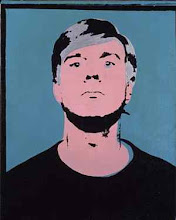 |
| Vladimir Tatlin, Monument to the Third International (model), 1920 |
In 1919 Vladimir Tatlin was commissioned... to produce a monument to the Russian Revolution... The building was to be made of iron and glass and was to extend to a height of 400 metres, one third higher than the Eiffel Tower... The framework consisted of two spirals supported by a strong diagonal set at the angle of the Earth's axis. This enclosed four enormous glass structures: a cylinder at the bottom, a pyramid, another cylinder and a hemisphere. These were intended to house the various departments of the Commintern and to rotate at various speeds: the lowest cylinder at one revolution per year, the pyramid at one revolution per month, and the top cylinder at one revolution per day. (Wilk, C. ed. (2006) Modernism 1914-1939: Designing a New World, London: V&A, p42)
 |
Left: Computer visualisation of Tatlin's Tower by Dixon Jones Architects; Right: Vladimir Tatlin (1885–1953), Monument to the Third International: side elevation, 1920, N. Punin Archive © Anna Kaminskaya |
 |
| Model of Tatlin's Tower by Jeremy Dixon in the Annennberg Courtyard, Royal Academy. Photograph by Miguel Santa Clara |
The exhibition examines the extraordinary burst of creative energy in art, architecture and design which followed the Russian Revolution and grew out of Constructivism. The drive to forge a new Socialist society in Russia encouraged synthesis between radical art and architecture. This creative reciprocity was reflected in the engagement with architectural ideas and projects of such artists as Kazimir Malevich, Vladimir Tatlin, Liubov Popova, El Lizzitsky, Ivan Kluin and Gustav Klucis, and in designs by such architects as Konstantin Melnikov, Moisei Ginsburg, Ilia Golosov and the Vesnin brothers, as well as Le Corbusier and Erich Mendelsohn, European architects who were draughted in to help shape the new utopia. (RA website) The exhibition continues until 11 December.
Read a review by Rowan Moore and a feature by Owen Hatherley.
 |
Vladimir Shukhov, Shabolovka radio tower, 1922. Photograph by Richard Pare |
 |
| Moisei Ginsburg, Narkomfin Building, 1928-32 |
 |
| Liubov Popova, Painterly Architectonics, 1918-19 |
 |
| Konstantin Melnikov, Gosplan Garage, 1934-36 |
 |
| Konstantin Menikov, Rusakov Club, 1927-29, photograph by Richard Pare |
As a footnote to the historical references to the ambitions of Tatlin's Tower, London's own 'constructivist' monument has just been completed: Anish Kapoor and Cecil Balmond's ArcelorMittal Orbit, commissioned for the Olympic Park for the 2012 games. Read Jonathan Glancey's positive 'review' and Rowan Moore's withering passing comment in his review of the RA exhibition: big metal thingies have become a cliche of wannabe cities and expo sites and Anish Kapoor is making another contribution to this pointless genre with his Orbit tower on the London Olympic site.
 |
| Anish Kapoor and Cecil Balmond, ArcelorMittal Orbit, Olympic Park, London. Photograph by Dave Hill |











No comments:
Post a Comment